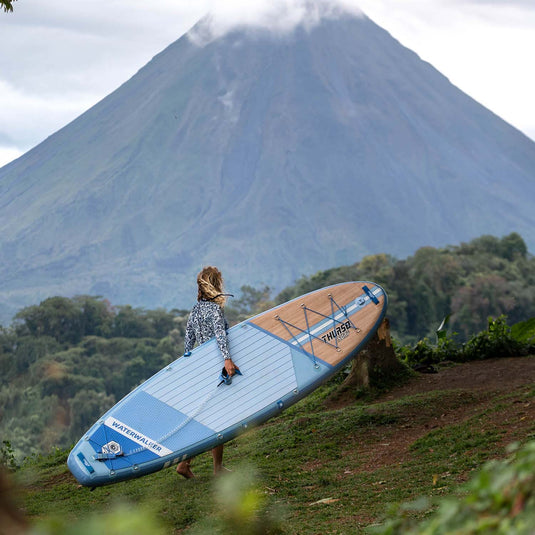Imagine gliding silently across a glassy lake at dawn, a light mist slowly rising from the water. You paddle into a secluded cove inaccessible to most motorboats, and then cast your line. The only sounds are the dip of your paddle, the whir of your reel, and maybe, just maybe, the splash of a rising fish. That's the appeal of kayak fishing .
The fishing kayak is more than just a new way to reach your fishing spots. It offers a unique blend of tranquility, secrecy, exercise, and access to waters often uncharted by larger boats. If you're intrigued by the idea but don't know where to start, you've come to the right place. Welcome to Fishing Kayak 101!

Why choose a kayak for fishing?
There are many reasons why an angler might want to switch from a motorboat to a kayak for fishing. Before we learn more about the equipment, let's get to grips with the compelling advantages:
- Stealthy & Quiet : Kayaks are very quiet. This allows you to approach fish without scaring them, which often leads to more bites.
- Access : Shallow waters, narrow bays, weed beds and narrow channels that are off-limits to larger boats become your personal playground.
- Cost-effective : Compared to motorboats, the initial investment and ongoing maintenance of a fishing kayak are significantly lower.
- Training & connection to nature : It is a fantastic exercise, and being close to water strengthens your connection to nature.
- Simplicity : The fishing kayak encourages a minimalist approach, focusing on the essentials and the pure joy of the sport.
What equipment do I need for fishing kayaking?
With a quality paddle and a quality boat, your day on the water will be much more enjoyable. Next, we'll introduce some of the most helpful accessories we recommend.
The fishing kayak
- Sit-on-Top (SOT) vs. Sit-In (SIT) : For fishing, a sit-on-top (SOT) kayak is almost always preferred. They are more stable, easier to get in and out of (especially in the event of a capsize), offer more space for gear, and have self-bailing vents.
- Stability is key : Look for wider kayaks (30+ inches) with flat hulls. Stability is synonymous with comfort and safety when casting, fighting fish, and (with some models) even while standing.
- Length: Longer kayaks (12-14 feet) travel straighter and are faster, better for open waters. Shorter kayaks (10-12 feet) are more maneuverable, ideal for rivers and narrow spaces.
- Drive :
Paddle : The most traditional and often cheapest option.
Pedal drive : Allows for hands-free propulsion, leaving your hands free for casting and retrieving. A deciding factor for many, but a higher investment.
The paddle
Regardless of the type of propulsion your kayak has, you always need a durable and reliable kayak paddle.
The WIN.MAX kayak paddle was specially developed for kayak anglers. It's a very lightweight travel paddle that can be disassembled into two parts, making it very easy to transport.
Life jacket for anglers (PFD)
Always wear it, even if you're a strong swimmer. Accidents happen quickly, and a life jacket is your most important safety gear.
Choose a high-back life jacket designed for paddling that won't interfere with the fit of your kayak. The NEOSPLASH is an excellent life jacket used by avid kayak anglers worldwide.
Fishing rod & reel
Fishing rod holders are an indispensable accessory for equipping a fishing kayak.
- Your existing gear: For your first few trips, your current freshwater or light saltwater spinning or baitcasting gear will probably be sufficient.
- Special kayak rods : Shorter rods (6–7 feet) are often preferred because they are easier to handle in tight spaces.
Simple fishing equipment & bait
Here's a simple guide to basic gear you'll need: a small tackle box with hooks, sinkers, a few versatile lures (e.g., soft plastics, jigs, a spoon), and line cutters.
Safety accessories for fishing kayaks
The key to success in fishing is the principle of "safety first." Please ensure that you have the best safety equipment and are well prepared on your fishing trips to handle any situation with confidence.
- Whistle: For signaling.
- Dry bag: Keeps your phone, keys, and wallet safe and dry.
- First aid kit: A small, waterproof emergency kit for minor cuts and scrapes.
- Water & Snacks: Stay hydrated and energized.
- Sun protection: Hat, sunglasses (polarized lenses are great for fish watching!), sunscreen.
- Communication: Fully charged phone in a waterproof case or a marine radio.
- Headlamp/navigation light: If there is a possibility that you will be traveling at dusk or in poor light conditions.
Additional equipment that makes a difference
A fishing kayak can be as simple or complex as you want. Many anglers have started converting their kayaks to mimic bass boats, including all the trolling motors and advanced electronics. Other anglers prefer simplicity when choosing the best accessories for their fishing kayak. Whether you want to outfit your kayak with all the accessories on this list or just make a few clever upgrades, the following accessories focus on safety, organization, comfort, and increased catch rates.
- Fishing rod holders : Most fishing kayaks are equipped with flush-mounted rod holders. Adjustable rod holders allow for different angles while trolling or waiting for a bite.
- Milk crate/Storage : A common and inexpensive way to store fishing tackle and equipment is behind the seat. You can attach your rod holder to it with a zipper.
- Anchor : A small grappling hook or mushroom anchor that holds your position in currents or wind.
- Net or lip grab : For safe landing and handling of fish.
- Fish finder : Not essential for beginners, but a popular upgrade for finding fish and understanding bottom structure.
- Boat dolly : A kayak dolly can help you effortlessly transport your kayak from your vehicle to the water while protecting your kayak's hull from scuffs, scratches, and damage. Treat yourself and your kayak properly. Use a boat dolly to transport your kayak from storage to your vehicle, then from the vehicle to the water, and finally back again.
Remember that kayaking is an incredibly rewarding activity that combines the thrill of fishing with the tranquility of being on the water. With proper preparation, the necessary equipment, and a focus on safety, you'll soon enjoy the unique freedom and excitement that only a paddle-powered fishing adventure can provide. If you'd like to learn more about launching your kayak, check out our instruction manual: Launching Your Kayak: A Step-by-Step Guide


